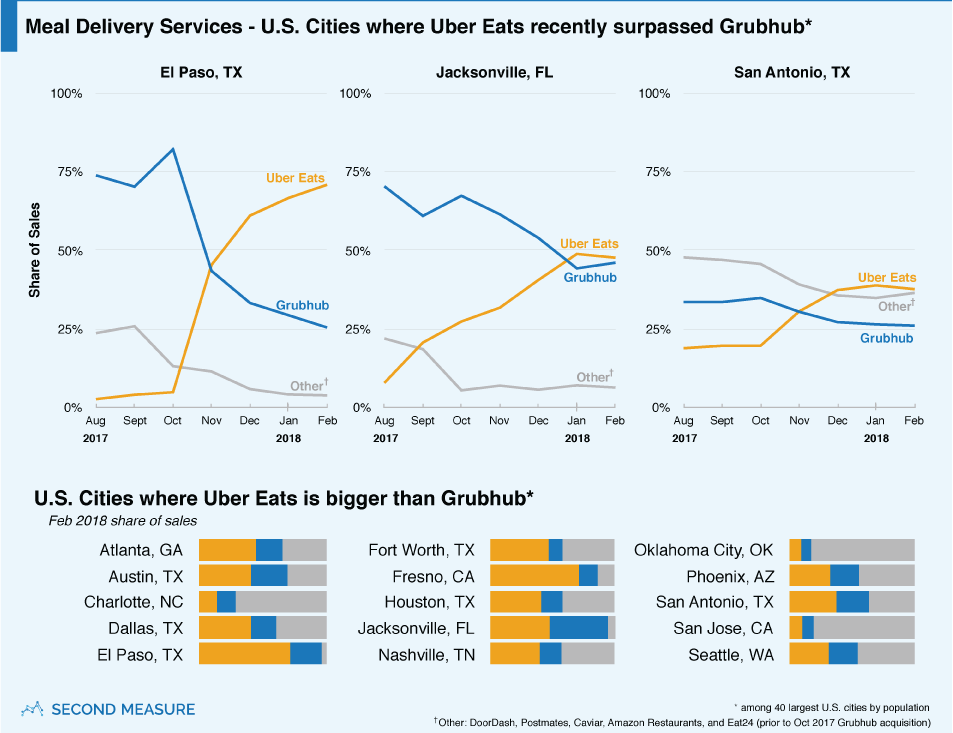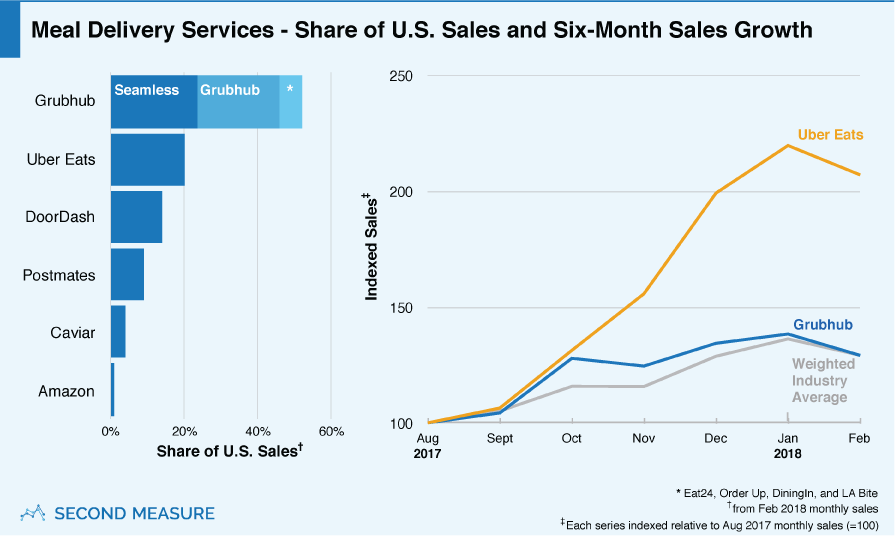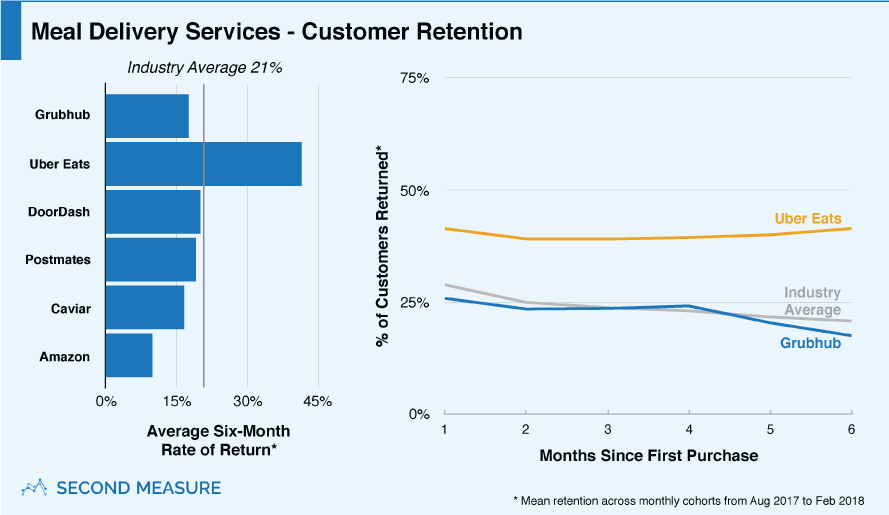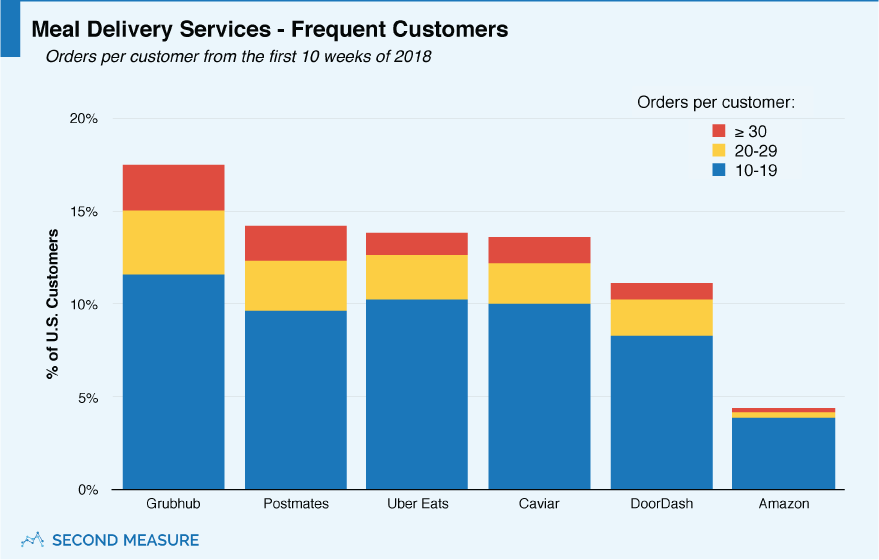NOTE: Bloomberg Second Measure launched a new and exclusive transaction dataset in July 2022. Our data continues to be broadly representative of U.S. consumers. As a result of this panel change, however, we recommend using only the latest posts in assessing metrics, and do not support referring to historical blog posts to infer period-over-period comparisons.
While everyone watches Uber’s stumbling market share and frequent bad press, its food delivery service, Uber Eats, is doing well—really well. It’s the fastest-growing company among meal delivery services and is bringing in, dollar for dollar, nearly as much new spending as the industry leader, Grubhub. Uber Eats now claims a larger market share than Grubhub in 15 major U.S. cities, including two markets that Grubhub dominated just six months ago.
Uber Eats heats up in Southern cities
In 15 of the 40 biggest U.S. cities, spending at Uber Eats now exceeds spending at Grubhub. Uber Eats saw dramatic gains in three cities where it recently became the market leader, and in two of those locations—El Paso and Jacksonville—Grubhub was top dog just six months ago.

Uber Eats also recently surpassed Grubhub in Charlotte and Oklahoma City, where other competitors still lead the market. The silver lining for Grubhub is that many of these markets are expanding rapidly, meaning Uber Eats isn’t necessarily stealing sales. In Jacksonville, total spending on meal delivery in February was up 86 percent from six months prior and, in El Paso, spending grew fourfold in that time.
Uber Eats’ sales grew faster than Grubhub’s
From August 2017 to February 2018, Uber Eats doubled its sales and came close to matching Grubhub’s dollar-for-dollar growth. Over those six months, Uber Eats’ sales gains were 88 percent of Grubhub’s. For Grubhub, that includes the October acquisition of Eat24, which accounts for nearly half of its six-month growth.
But Uber Eats still has a long way to go to catch up to the industry leader. In February, Grubhub pulled in more than half of all U.S. sales among major competitors. As runner-up, Uber Eats captured nearly one-fifth. A rumored merger between mid-sized competitors DoorDash and Postmates would give the newly formed company 23 percent market share, putting it ahead of Uber Eats (at least for now).

What keeps Grubhub on top? Its secret sauce includes a mix of expanding its own footprint and buying up the competition. Grubhub acquired Seamless in 2013 and has since purchased DiningIn, Eat24, and others. As a result, 12 percent of American consumers have spent money with Grubhub.
Only 3 percent of consumers have tried Uber Eats, but that number is rising fast, possibly due to its partnership with America’s largest fast-food restaurant: McDonald’s. As of May 2017, Big Mac lovers can get their burgers delivered by Uber Eats and, presently, one-third of U.S. McDonald’s restaurants are participating. Since the McDonald’s deal took off, other delivery companies have been eager to pair up with fast food chains. DoorDash began a partnership with Wendy’s in December, and Grubhub recently announced a deal with Yum Brands to provide delivery for Taco Bell and KFC.
New customers keep coming back to Uber Eats
Uber Eats is also the most successful service when it comes to retaining customers, an important way to boost sales. On average, 41 percent of its customers used Uber Eats six months after their first order. That number was just 17 percent at Grubhub.

By capitalizing on receptive delivery markets, Uber Eats sees more customers return than the other mid-sized competitors, DoorDash and Postmates. Customers can order via Uber Eats in about 100 U.S. metro areas, where delivery services are especially popular among urbanites. Grubhub operates in a whopping 1,600 U.S. cities, reaching a wider distribution of customers who, in some locations, may have a smaller selection of participating restaurants to keep them coming back.
Frequent delivery diners choose Grubhub
While Uber Eats may be the standout in retention, Grubhub still attracts high-frequency customers better than any other service. The convenience of delivery can become habit-forming, and Grubhub has some people hooked. In the first 10 weeks of this year, 17 percent of Grubhub’s customers ordered food at least once a week, on average. And over 2 percent of its customers placed orders an average of three times per week or more. At Uber Eats, that number was only 1 percent.

Highly engaged customers are valuable to meal delivery services, all of which pull in roughly half of sales from their top 10 percent of spenders. With spending at Uber Eats on the rise and DoorDash planning a huge expansion, should Grubhub be worried about having these whales poached? For now, probably not. In just six months, spending across all meal delivery services grew by 29 percent nationwide, meaning fresh demand for delivery is still on this rise.
To take away more insights from our meal delivery data, get in touch and request a demo.
Oh, and we’re hiring.
